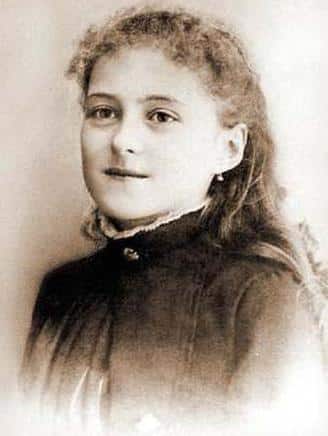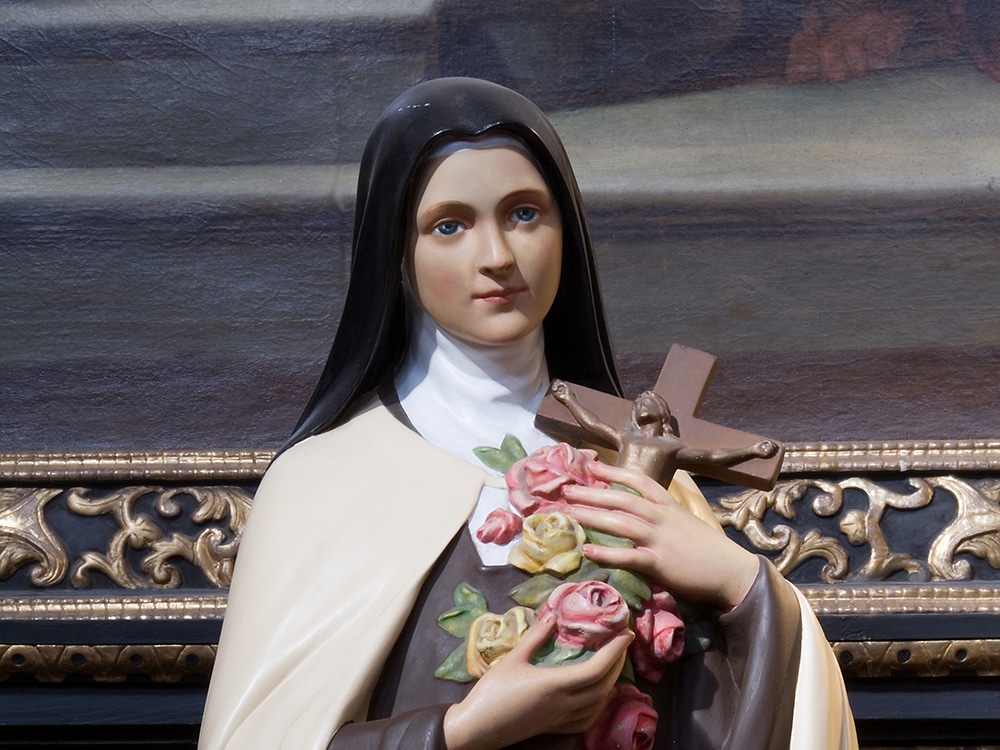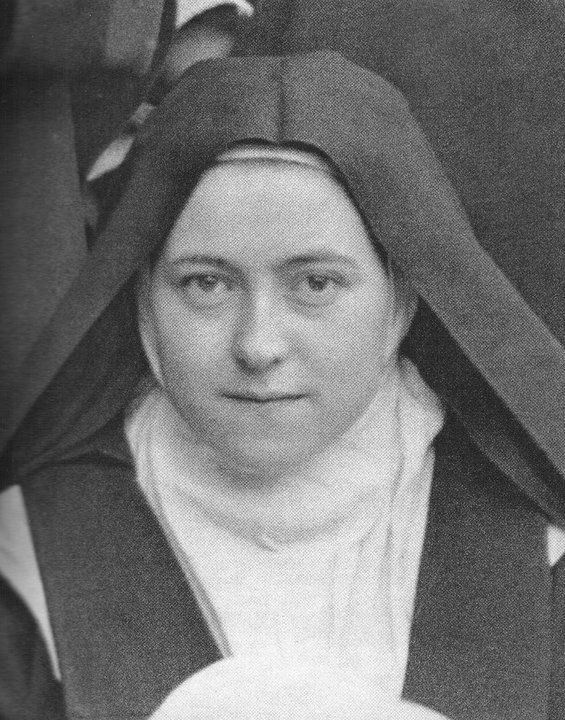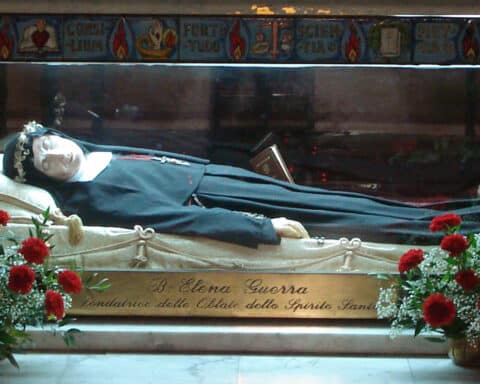If all we knew about St. Thérèse of Lisieux was that she called herself God’s “little flower,” we might conclude that she was a hopeless sentimentalist. But read her autobiographical classic, “The Story of a Soul,” and you find that, despite some sentimental rhetoric typical of her times, this was a strong, realistic young woman, wise beyond her years, with a will of iron where her vocation and sanctity were concerned.
Admittedly, though, it wasn’t always so.
Born Jan. 2, 1873, Marie-Françoise-Thérèse Martin was the youngest of nine children of Louis and Zélie Martin and grew up in a loving, deeply Catholic family. Four of her sisters became nuns — three Carmelites like herself and one a Visitandine. But after her mother’s death, Thérèse, age 4, became a temperamental child, given to tantrums when things weren’t exactly as she wanted and likely to burst into tears at the drop of a hat. “I really made a big fuss over everything,” she later wrote.

On Christmas Eve in 1886, Thérèse, following tradition, placed her empty shoes on the hearth to be filled with presents and candy. Returning from Midnight Mass, she and her sister, Celine, were going upstairs to put their hats away before opening their gifts when they heard their frazzled father say, “Fortunately, this will be the last year.”
Fearing her little sister’s reaction, Celine told Thérèse not to go downstairs again. And then it happened. “I felt charity enter into my soul, and the need to forget myself and to please others.” Rushing downstairs, she took her shoes to her father and joyfully opened her gifts while he watched and laughed. It was the turning point of her life.
Filled with “a thirst for souls,” Thérèse took up the cause of Henri Pranzini, a murderer under sentence of death, and stormed heaven with prayers for his repentance. When the time came for Pranzini to die, a priest held out a crucifix to him, and he kissed Christ’s wounds three times. Thérèse felt certain that he was saved, and now the desire to save souls became a permanent part of this formerly self-absorbed child’s life.
Read more articles from the Turning Points series here.
Seeing her older sisters enter the Carmelite convent in Lisieux, France, Thérèse longed to do the same. In November 1887, her father took her and Celine on a diocesan pilgrimage to Rome, and she boldly seized the opportunity of an audience with Pope Leo XIII to ask him to tell the authorities to allow her to enter Carmel despite being underage.
“You will enter if God wills it,” the startled pope told the 14-year-old girl. Thérèse had hoped for more, but soon the local bishop gave his approval, and on April 9, 1888, she entered the convent. Two years later, she made her vows. She took the name Thérèse of the Child Jesus and the Holy Face.
For the occasion, she wrote a “wedding invitation” that read in part: “Being unable to invite you to the Nuptial Blessing which was given on Mount Carmel, September 8, 1890 (the heavenly court alone was admitted), you are nevertheless asked to be present at the Return from the Wedding which will take place Tomorrow, the Day of Eternity, on which day Jesus, Son of God, will come on the Clouds of Heaven in the splendor of His Majesty, to judge the Living and the Dead. The hour being as yet uncertain, you are invited to hold yourselves in readiness and to watch.”
As those high-spirited words suggest, Thérèse was intensely happy. But having found life in a strict convent to be no bed of roses, she resolved to look for opportunities to show affection and kindness to the least friendly sisters in her order. The story of Sister St. Pierre illustrates how she went about that.
While still a novice, she volunteered to accompany this elderly, grumpy nun from choir to dinner every day, holding her cincture to keep her steady. “But if by mistake she took a false step,” Thérèse recalled, “immediately it appeared to her that I was holding her incorrectly and she was about to fall. ‘Ah! My God! You are going too fast; I’m going to break something.’ If I tried to go more slowly: ‘Well, come on! Ah! I was right when I said you were too young to help me.'”
Reaching the refectory at last, Thérèse helped the old nun get seated, turned up her sleeves — just the way her companion wanted them — and prepared to leave. But one day, she observed that arthritis made it hard for Sister St. Pierre to cut her bread. So, without being asked, she cut the old woman’s bread, “gave her my most beautiful smile,” and left. “It was by this means that I gained her entire good graces.”
Through the daily multiplication of such small incidents, Thérèse perfected her famous “little way” to holiness. Being a small person with a small soul, she reasoned, she lived in an environment that invited only small deeds of kindness. But perform those acts with great love in total obedience to the will of God and the result was something great.
“My vocation is love,” she wrote. To explain her meaning, she cited a technological marvel of the day: “I, too, would like to find an elevator to lift me up to Jesus, for I am too little to climb the rough stairway of perfection.” Addressing her prioress, she explained: “My dear Mother, you can see that I am a very little soul and that I can offer God only very little things. … I ask Jesus to draw me into the flames of his love, to unite me so closely to him that he live and act in me.”
As assistant to the mistress of novices, Thérèse practiced the little way in that role, humble with some and “severe” with others, depending on what was best for each. At the request of the prioress, she also became spiritual sister to two French missionary priests, one in North Africa and the other in Indochina, praying for them and writing letters of spiritual guidance and encouragement. And she wrote poems and playlets, performed by the sisters, about Joan of Arc.
On the night of Holy Thursday in 1896, Therese coughed up blood, a sign of the onset of tuberculosis. She welcomed the illness that would speed her journey to heaven. On July 8, 1897, she was transferred to the convent infirmary. Her death was slow and painful and was accompanied by temptations against faith. On July 17, she made a prediction:
“I feel that my mission is about to begin, my mission of making others love God as I love him, my mission of teaching my little way to souls. If God answers my requests, my heaven will be spent on earth up until the end of the world. Yes, I want to spend my heaven in doing good on earth.”
She died on Sept. 30, 1897, at the young age of 24.
St. Thérèse of Lisieux was beatified by Pope St. Pius X and canonized on May 17, 1925, by Pope Pius XI. Pope St. John Paul II declared her a Doctor of the Church in 1997. She is also recognized, with St. Francis Xavier, as patroness of missions and missionaries and, with St. Joan of Arc, as secondary patroness of France. Her parents, Louis and Zélie Martin, were canonized by Pope Francis in 2015.
Written at her superiors’ direction, “Story of a Soul” was published in 1898 in an edition of 2,000 copies. Since then, it has been translated into more than 30 languages and sold millions of copies. Its final words, in a sentence its author never completed, are, “I go to God with confidence and love. …”
Russell Shaw writes from Maryland.






